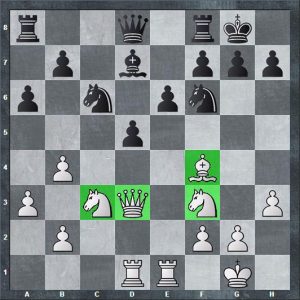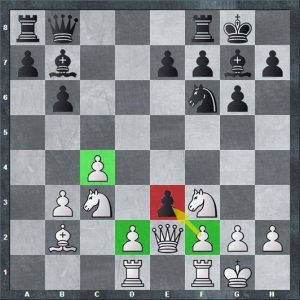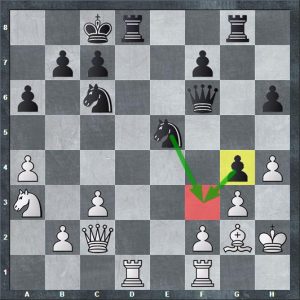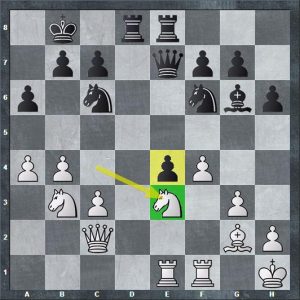Most chess players have a general idea of how to play the opening.
However, they have problems understanding the middle-game strategies because it is not very straightforward and does not have a simple “opening idea” of developing pieces, putting the king to safety, etc.
After reading this article you will learn seven most important principles of the middle-game.
1. Centralize your pieces
It is a well-known fact that in the centerpieces control a lot more squares than elsewhere. This is an especially important rule to remember when dealing with the knights. The knights can control as many as 8 squares when centralized, while only 2 square if cornered.
It is true that bishops can be very effective from the flank. However, in the center, they are more mobile and control both parts of the board. The same goes for the queen. If it is safe, bishops and queen should be centralized as well as knights.
Notice how white has centralized four of his pieces.

White to move
2. Trade your flank pawns for the central pawns
The central pawns are generally considered to be more valuable than the flank pawns. This is because central pawns allow controlling important central squares (d4-d5-e4-e5) which can be used to support pieces and develop a strong attack not only in the center but also on the king’s or queen’s side. At the same time, central pawns provide space and increase pieces of mobility.
Therefore, it is recommended not to trade your central pawns for the opponent’s flank pawns. In fact, you should do the opposite and exchange your flank pawns for the opponent’s central pawns.
White should play fxe3 to create a strong pawn center with e-d-c pawns.

White to move
Tip:
In order to understand how to play middle-games well it is important to have a deep positional understanding. In order to improve your positional understanding, we suggest you sign up for our comprehensive training course.
Over 1,000 chess players have already benefited from our training. Don’t wait, start winning chess games today.
3. Avoid pawn weaknesses
A pawn weakness is something that can give your opponent an instant edge and allow him an easy game by exploiting them. That is something that can turn an otherwise equal endgame into a loss. To avoid endgame trouble you need to take care of the pawn structure right from the opening and middle-game.
Avoid doubled, backward, and isolated pawns.
In the position below both white and black have serious pawn weaknesses. White has doubled and backward pawns, while black have isolated pawns.

White to move
4. Avoid creating weak squares in your position
A weak square is a square that cannot be protected by a pawn. Weak squares in your position are perfect candidates for becoming strong outposts for your opponent’s pieces. The closer the weak square is to your king’s position or to the center, the bigger trouble it usually creates. Always be careful with pawn advances, since that is what creates the weak squares. Pawns can’t go back.
On the diagram below white has a weak f3 square right next to his king’s position. It can be soon used by the black knight and queen to create mating threats.

Black to move
5. Always blockade your opponent’s isolated pawn with a knight
An isolated pawn is a powerful weapon and can be used by your opponent to launch a strong attack because it supports pieces and provides extra space. Another danger of isolated pawn is that it can be pushed forward at the right time causing many problems. That’s why it is very important to always blockade the opponent’s isolated pawn to avoid complications. The best piece for this purpose is indeed the knight.

Black to move



0 σχόλια:
Δημοσίευση σχολίου